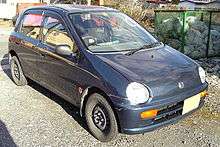Honda Today
| Honda Today series JW1-4 & JA1-5 | |
|---|---|
 1990-1993 Honda Today JA2 | |
| Overview | |
| Production | 1985-1998 |
| Body and chassis | |
| Class | Kei car |
| Body style |
3-door hatchback 5-door hatchback (2nd gen only) |
| Layout | Front engine, Front-wheel drive / Four-wheel drive |
| Powertrain | |
| Engine |
545 cc EH I2 547 cc E05A I3 656 cc E07A I3 |
| Dimensions | |
| Wheelbase | 2,330 mm (91.7 in) (1st and 2nd gen) |
| Length |
3,195 mm (125.8 in) with 550cc engine (1st gen) 3,295 mm (129.7 in) with 660cc engine (1st gen) 3,295 mm (129.7 in) (2nd gen) |
| Width | 1,395 mm (54.9 in) (1st and 2nd gen) |
| Height |
1,315 mm (51.8 in) with 550cc engine (1st gen) 1,350 mm (53.1 in) with 660cc engine (1st gen) 1,370 mm (53.9 in) (2nd gen) |
| Curb weight |
640 kg (1,411.0 lb) with 550cc engine (1st gen) 760 kg (1,675.5 lb) with 660cc engine (1st gen) 760 kg (1,675.5 lb) (2nd gen) |
| Chronology | |
| Predecessor | Honda Life (1974) |
| Successor | Honda Life (1997) |
This Honda Today was a kei car (minivehicle) produced by the Japanese automaker Honda beginning in 1985. It was replaced by the Honda Life in 1998. Honda's smallest car being produced at the time was the Honda City, which was a supermini and it had an engine larger than kei car legislation allowed. The Today represented a re-entry into kei car production. Honda had abandoned kei passenger cars in 1975, choosing to manufacture the Honda Acty kei truck, and the Honda Street microvan for that segment. Previously, Honda's smallest car was the Honda Civic, followed by the smaller Honda City in 1981.
History
Early

The first generation Today was introduced in September 1985 as a three-door hatchback, on a wheelbase of 2,330 mm (91.7 in). The Today was initially launched with three different model specifications, with the entry model being model 'F', followed by a model 'M' and the top of the range 'G'. The Today was only intended for the Japanese domestic market.[1] It was introduced at newly established Japanese dealerships called Honda Primo locations alongside the Primo "headliner" sedan, the Honda Civic. The flat roof hatchback design appearance was shared with the incrementally larger supermini Honda City, the subcompact Honda Civic, and the compact Honda Accord AeroDeck. Originally available with either a four-speed manual or a three-speed automatic, it was powered by a water-cooled two-cylinder Honda EH series OHC 545 cc engine - the same as used in the Acty kei truck.[1] In a market where three-cylinder engines were the norm, this unit was outdated and was replaced by a three-cylinder four-valve E05A 547 cc engine by February 1988. The rear axle was a torsion beam with coil springs. Together with the new regulations in March, 1990 the bumpers were enlarged to give the car a length of 3,295 mm (129.7 in), and the engine was enlarged to 656 cc. By April 1990, came a permanent four-wheel drive version with an independent rear axle.
In January 1993, a redesigned Honda Today was announced. The car did not have a hatchback; in its place was a trunk lid that opened downwards to form a tailgate, like the 1991 Civic three-door (the Today's rear window does not open). The interior is not symmetrical: the driver's seat is slightly larger than the front passenger seat. These features were decided on after research indicated that the car's target audience were mostly single young women who often drove alone, with little need for cargo space. Initially only available as a two-door, in May 1993 a four-door version was added, named the Today Associe.
The 1993 Today was available with two engines, a standard 656 cc three-cylinder fuel injection engine, and a high output version of the same engine with MTREC technology, borrowed from the Honda Beat. Both engines were available with either a five-speed manual or a three-speed automatic gearbox. All wheel drive (using realtime 4WD technology) was available with the Q trim level.
For the Today's early-1996 facelift, Honda eliminated the tailgate rear door, and replaced it with a traditional hatchback door. This necessitated some redesign in the rear end, because the rear window had originally wrapped around to the sides. One characteristic shared with both generations was the use of only one windshield wiper arm for the front windshield due to the vehicles small dimensions.
End
In light of the Suzuki Wagon R's success, Honda decided to introduce a modern version of its 1970s Honda Life "StepVan" microvan, and reintroduced the Honda Life model name in 1997. When the kei car regulations changed in October 1998, necessitating a redesign, the Life received a redesign, while the Today, which was a modern interpretation of the first Honda Life three-door hatchback, was discontinued.
Media appearances
The Honda Today featured frequently in Kōsuke Fujishima's You're Under Arrest as the main transport for the lead characters. The vehicle featured was a highly personalized minipato (police mini patrol car) with modifications such as nitrous oxide, turbo and others, and with a Motocompo folding bike stowed in the back compartment.
The Honda Today is also featured in Gran Turismo 4.
It appears alongside many of its kei car contemporaries in Kat's Run: Zen-Nippon K Car Senshuken for the Super Famicom.
References
| Wikimedia Commons has media related to Honda Today. |